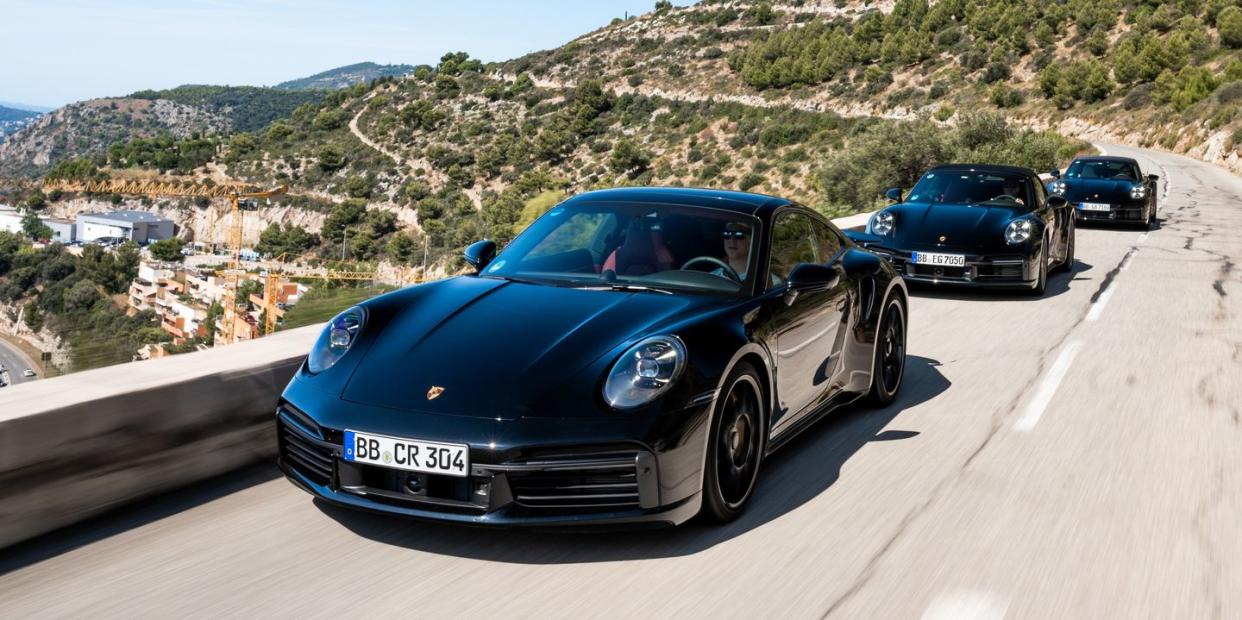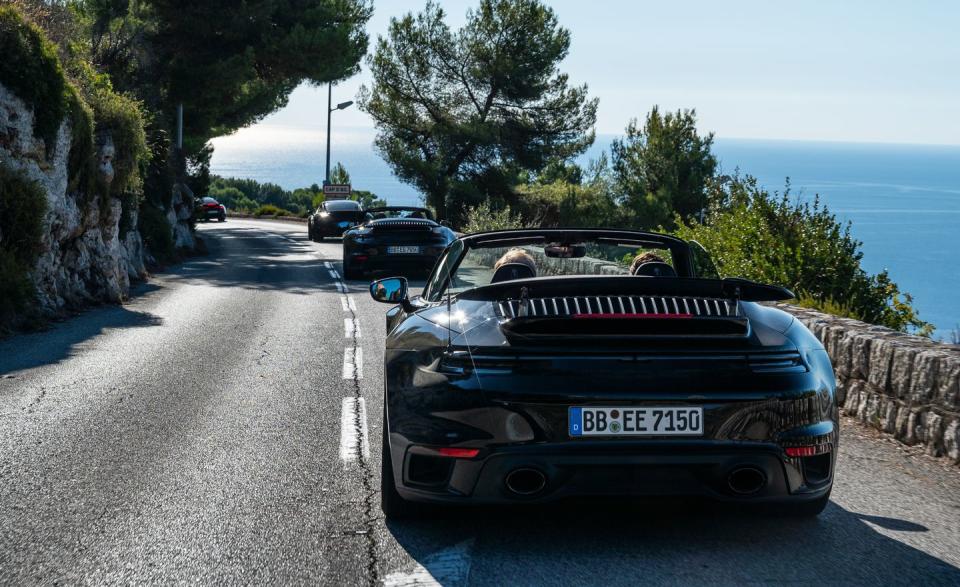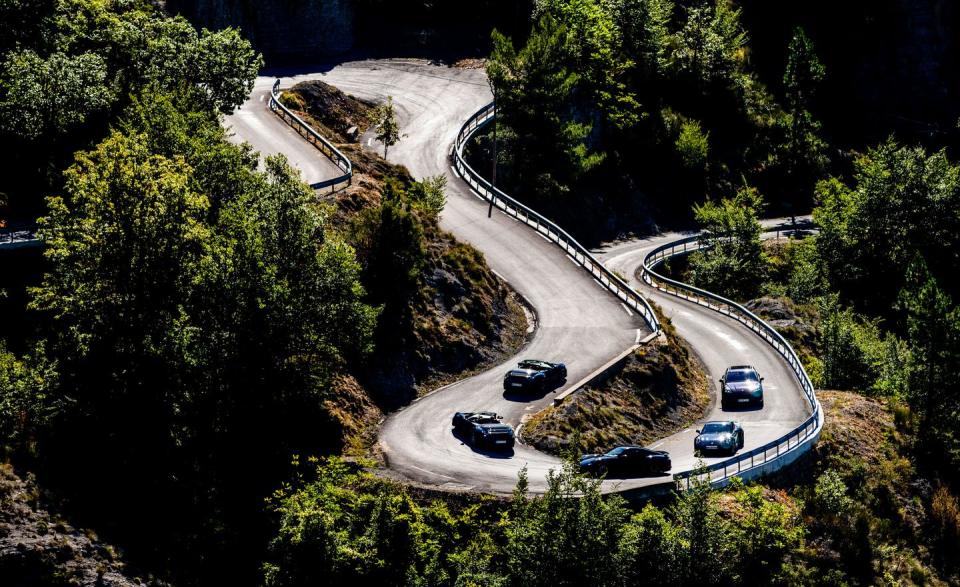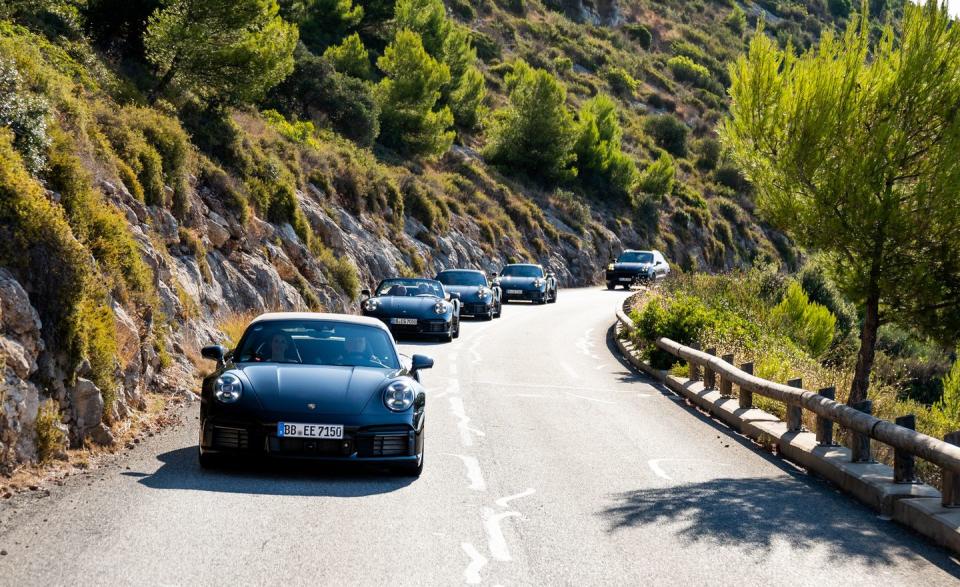Everything We Learned Riding in the 2020 Porsche 911 Turbo S

Diminishing returns don't carry much weight at Porsche, but the 911 Turbo S does.
The last Turbo S we tested, a 2018 model, weighed nearly 3600 pounds and hit 60 mph in 2.6 seconds. Porsche claims the new 992-generation Turbo S—which gains 110 pounds—will be 0.1 second quicker to that same milestone. Of course, normal humans likely won't notice that difference in acceleration, and in the grand scheme of ultra-fast cars, it's just testing noise. But as Porsche chips away at the 911 Turbo S's zero-to-60-mph time, persistently shrinking an already small number, 0.1 second, well, it becomes statistically significant.
Though the next-generation 992 911 Turbo S won't be formally announced until spring 2020, we recently rode in coupe and cabriolet test mules in the mountains of France and Italy, constantly reminding ourselves that some days on this job are better than others. Among the highlights were interviews with engineers, mountain-pass slayings, and one unforgettable launch-control demonstration.

"I make now a quick start," said Christian Kunkel, Porsche's head of development testing. His words, stoically German, utterly understated the severity of what we experienced. Because when he released the car's brake pedal, we were immediately and powerfully reminded that shaving a tenth of a second from the zero-to-60-mph time of a car that already clears that mark well below three seconds is a mind-bending achievement. It's also a face-bending achievement.
A Simple Formula, Really
So, how is this achieved in a heavier 911? It's simple, really. Porsche relied on that great problem solver made famous by Mark Donohue: power. At 580 horsepower, the previous 991.2 Turbo S was no slouch, but because competitors such as McLaren and Ferrari flaunt power like America flaunts all-you-can-eat specials, Stuttgart had to turn the knob quite a bit more. And they turned it all the way to 641 horsepower. That's an early number and one that might still change as the car nears production, but the fact that it works out to a nice, round 650 metric horsepower tells us that it's likely to stick around. Torque is up, too, from 553 lb-ft to 590.
The primary motivational hardware—a twin-turbocharged 3.8-liter flat-six—remains largely unchanged with the exception of iron cylinder liners, cast-iron exhaust manifolds, and piezoelectric fuel injectors. But significant tweaks have been made to the engine's respiratory abilities. It's only appropriate that the new Turbo has bigger turbos. Both the turbine and compressor housings are upsized on the 992 Turbo S's BorgWarner variable-geometry turbochargers. Peak boost is 17.4 psi. The 992's intercoolers are relocated from behind the rear wheels to directly above the engine. Redesigned catalytic converters, which yield less back pressure, also improve flow. Further downstream is an optional sport exhaust that can change the system's volume and sound, which is a first for a 911 Turbo.

More power, of course, produces more heat, and the 992 went through a rigorous development cycle to prove that it's capable of rejecting the additional thermal load. With a larger frontal area than the 991.2, the 992 had enough cooling flow through its front-mounted heat exchangers, but—and possibly you've noticed this about the 911—that's not where the action is. According to Frank Walliser, vice president of the 911 and 718 model lines, 15 components failed the 992's heat-stress testing during development. Multiple strategies were at play in the cars we experienced—which performed flawlessly, by the way—to manage heat. New heat shielding, updated materials, additional pathways for cooling air above the hottest components, and two electric fans to move air over the engine are part of the 992 Turbo S's thermal-management strategy.
Putting the Power Down
All-wheel drive remains standard and an eight-speed dual-clutch automatic is the only available transmission. The gearbox uses the same ratios as the 911 Carrera, but a revised final-drive ratio is necessary to achieve the Turbo S's claimed 205-mph top speed. There's an electronically controlled limited-slip rear differential and a hydraulically controlled limited-slip center differential. The front differential is open.

Porsche's Active Suspension Management with two damping modes—Normal and Sport—is standard on the 992 Turbo S, as is rear-wheel steering. An optional Sport suspension mode lowers the car 0.8 inch relative to the 991 Turbo and 0.4 inch versus the base 992 Turbo S setup. All 992 Turbo S 911s will get carbon-ceramic brake rotors that span 16.5 inches in the front (0.4 inch bigger than the 991.2's). The 15.4-inch rear rotors are the same as the previous 911 Turbo's. Porsche's new 10-piston caliper is employed in the front where the previous 911 Turbo S employed an eight-piston unit.
Staggered 20- and 21-inch wheels that are 0.5 inch wider than before replace the 20-inchers that were at all four corners on the previous Turbo. The new car's Michelin Pilot Sport 4S tires are slightly wider—255/35R-20 in front and 315/30R-21 at the rear—than those on the outgoing 911 Turbo S.
Of course, being a 992-gen 911, the new Turbo S is bigger than the outgoing car. It's 0.8 inch wider at the rear fenders than the previous Turbo and 2.1 inches wider than the 992 Carrera. Its rear wing is larger than the one on the 991.2 Turbo S. An adjustable front splitter remains part of the aero package but adds 0.4 inch of travel versus the 991 Turbo, resulting in 220 pounds of downforce at 205 mph.
That the new 911 Turbo S deploys all of Porsche's latest findings into one intensely rapid and yet still comfortable package remains its true identity. Walliser, who is as intimately familiar with the car as any auto executive could possibly be, says he's most proud that the new car gains power and performance without compromising its comfort. He's surely accepted that it is heavier with the knowledge that even a few tenths—tiny increments though they may be—represent a significant improvement in Porsche's do-all performance 911.
You Might Also Like

